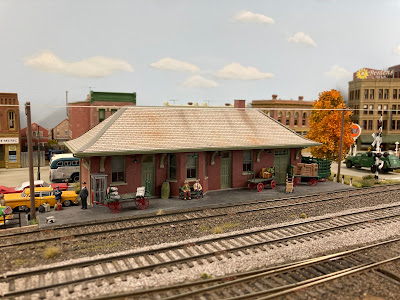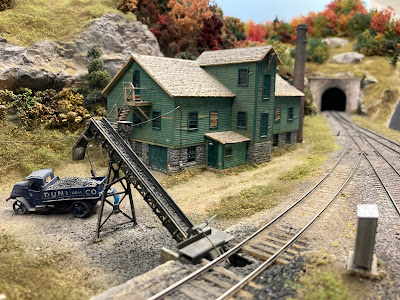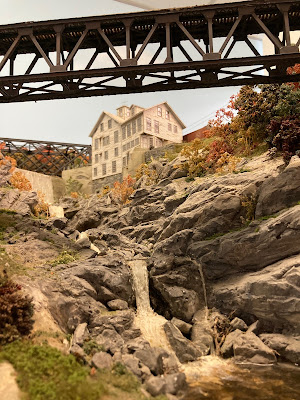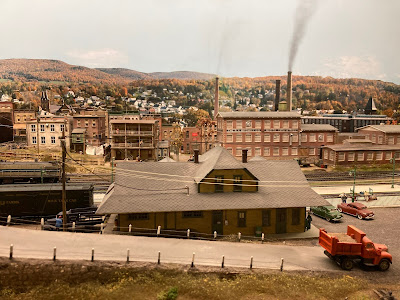Thursday, September 30, 2021
Happy October!!
Tuesday, September 28, 2021
Monday, September 27, 2021
On the New Haven Railroad 80 Years Ago Today... Cycle Trains
(Ok - so this post has nothing to do with the Valley Line, and I post it on this day every year, but I include it because it gives me a chance to combine my two primary passions: the New Haven Railroad & bicycling. It's also an absolutely wonderful window into the past - a veritable time machine, a trip down Memory Lane despite the fact that you're viewing it on a computer or tablet. So, turn back the pages of history and get a little glimpse of what life was like in New England on the New Haven Railroad on the eve of World War II, exactly 80 years ago today . . .click to cue the music)
September 28, 1941 was a Sunday. An early autumn day in Southern New England, clear and mild.
World War II had been raging in Europe for exactly two years this month. The German army had advanced into the Soviet Union over the summer and was riding high on the success of having already conquered most of Western Europe. France had just been split into German-occupied and Vichy zones the previous month.
It wasn't learned until much later that at some point in the days leading up to September 28, 1941, there was an important meeting concerning Nazi Germany's capacity to develop nuclear weapons. We thought the atomic age didn't start until four years later.
We didn't yet have to "Remember Pearl Harbor."
On this particular Sunday, the Japanese were celebrating the 10 year anniversary of occupying China's northeast territory of Manchuria. At some point during that same day, perhaps as some sign of heaven's outrage at such an audacious celebration, the sun was blacked out during a total eclipse visible in most of China - from just northeast of the Black Sea to the Pacific ocean.
Just three weeks earlier, the Japanese government assured President Roosevelt that it had "no imperialist designs on any foreign nation."
Britain had survived the Blitz, which ended the previous May - the same month Glenn Miller first recorded "Chattanooga Choo Choo" which was featured in a hit movie starring Sonja Henie. "Blue Champagne" by the Jimmy Dorsey Orchestra was the #1 song of the land on September 28, but the Henie movie, "Sun Valley Serenade," was released to theaters exactly a month earlier. By then "Chattanooga Choo Choo" was already a top ten on the Hit Parade, well on its way to becoming the first gold record ever the following February. It was the nation's #1 hit by that December.
Bobby-soxers fed the voracious appetite of juke boxes across the country one nickle at a time and made Frank Sinatra the top male vocalist that year.
Families had probably gone to church that Sunday morning in Connecticut, though some navy yard workers may have slept in having worked so hard to launch the Gato Class submarine USS Greenling (SS-213) at the Electric Boat Co., in Groton the previous Saturday. Some were still marking the 3 year anniversary of the Great New England Hurricane that devastated the Connecticut coast and rendered Hollywood screen siren Katherine Hepburn temporarily homeless, having to rebuild her family's home in Old Saybrook.
But there was no sign of bad weather on this day, and at least a few folks took advantage of the beautiful Sunday afternoon to go for a bike ride and have a picnic - all courtesy of the New Haven Railroad.
There aren't many left that remember the "Hobby Trains" run by the New York, New Haven & Hartford Railroad (aka the "New Haven") during the late 1930s and early 1940s. In an effort to boost ridership, the New Haven took advantage of the fact that their railroad connected the Great Metropolis of New York with New England. There were camp trains in the summer and ski trains in the winter. Photography specials in the spring and all year 'round. But what better time for a Bike Train than Autumn and what better place than the Berkshire Hills?
Thanks to a discovery of raw film footage by the NHRHTA, we can go back to that Sunday almost eight decades ago and enjoy the sights of a pre-war bike ride. You'll have to pedal your single-speed cruiser over a bunch of rolling hills before you get to eat. Don't worry if you have to walk up some of them - and ladies, be sure to mind your skirts that they don't get caught in the spokes. There are no "rest stops" as we think of on 21st century rides - bits of orange and Powerbars - but an entire spread complete with potato salad, Boston baked beans, chicken and watermelon awaits us.
So give your Schwinn, Columbia or Raleigh to the porter to put in the baggage car, give the conductor your ticket, and enjoy the trip. The train is about to arrive at the station . . .
Hope you enjoy this additional little journey down Memory Lane . . .
Friday, September 24, 2021
Friday Fun - Ops Session Success!
 |
| Crew Register & Era-appropriate radio |
Between "OP"toberfest last weekend and a Valley Line session last night, there's been lotsa operatin' goin' on lately. And it's about time - before last weekend, I hadn't been to an operating session since "COVID Eve" (literally the day before we were all sent home from work) at James Mayo's layout. And the last time I had a full Valley Line session (I'm not going to count the Spontaneously & Substantially Shorting Shakedown Session of Summer, 2021 since the Shore Line trains didn't run) was January 23, 2020.
 |
| Signing the Crew Register |
- Since returning all the "leased" cars (borrowed from BillS), I discovered I need more flatcars and gons.
- Need to edit/update some of my documents (spreadsheet, checklist, ops protocols, bulletin order)
- Definitely need to update/change the trackplan on the Saybrook Control Board to reflect long-ago changes to the track arrangement (and need to do the same for the Dividend track map to reflect more recent changes).
 |
| Roman bringing PDX-1 eastbound into Old Saybrook |
 |
| Pieter (center) bringing PDX-2 into Saybrook while the tower operator (Bill) makes sure neither he nor PDX-1 foul the Shore Line |
 |
| Tom (foreground) works "West End" staging while Pete works the Airline local in Somerset |
 |
| Randy & Dick operate the Valley Local in Wethersfield |
 |
| Pieter's made it into Essex while Tom looks on |
 |
| It's fun watching the parade of trains through Old Saybrook from the "bleachers" (basement stairs) |
 |
| Pete's made it to Middletown with the Airline local, while Dick switches the north end of yard |
 |
| Bob looks on from "East End" staging while Pieter finishes his work with PDX-2 on the Saybrook wye |
Tuesday, September 21, 2021
Monday, September 20, 2021
On the New Haven, 83 Years Ago Today . . .The Great New England Hurricane
September 21, 1938 marks a somber - and for the New Haven Railroad, a devastating - event in history.
The New Haven's Shore Line route was hit especially hard. . .
But the railroad - despite being in receivership after having gone into bankruptcy a few years earlier - restored its many washed-out lines in record time. The little booklet above tells the story:
"On September 21st, 1938, with flood waters already threatening major washouts at important points along the New Haven Railroad where the tracks paralleled or crossed the swollen torrents of New England's rivers...suddenly, just before dark, in the teeth of a howling southwest gale which increased momentarily to hurricane proportions, a steadily rising tide which in some places rose twenty feet in as many minutes, swept inland along the New England coast-line across the Shore Line Route of the New Haven Railroad...carrying on its crest hundreds of boats, ships, cottages, buildings, and wreckage. Communications by rail, wire, and telephone with many devastated areas was completely cut off. No one realized as yet what a staggering blow had been dealt by this combined hurricane - tidal wave - flood throughout the length and breadth of southern New England. But the next morning revealed a grim picture of death and desolation. Where fast freights and through passenger trains, including the crack Shore Line Limiteds had sped in rapid succession between New York and New England points carrying passengers, mail, express, and the vital necessities of life...now miles of silent track hung at crazy angles over yawning chasms in a hopeless tangle of power lines, signal towers, houses, boats, and thousands of tons of debris. Further inland at Hartford, Springfield, Norwich, Willimantic, and Putnam the hurricane had left its toll of felled trees and communication systems, crumbled freight sheds and roofless factories...and to add to the chaos, the raging rivers from the north broke through dams and temporary dikes, washing out railroad bridges and miles of track...rendering useless the strategic points through which Shore Line trains might have been re-routed. The vital life-line between New England and points south and west had been effectually severed. It had to be restored without delay. Thousands of men were needed for the Herculean task of rebuilding a railroad. The summoning of trackmen, engineers, skilled repair crews, and laborers had to be carried out without the help of modern communications systems. In an incredibly short time an army of 5,000 men were at work...toiling 24 hours a day in 3 shifts...many of them eating and sleeping in work trains and Pullman cars on the job..."For more photos, be sure to check out this site.
Those of us living in New England a few years back went through "Superstorm Sandy" and got a taste of what The Great New England Hurricane might have been like. But, as it turns out, it was a pretty small taste - as bad as Sandy was, it didn't come anywhere close. Check out this site for an eye-opening comparison of the two storms.
There are fewer and fewer folks that have first-hand memories of that fateful day over 80 years ago, but thanks to the extensive coverage the storm received - not to mention the wonders of the internet that allow all that coverage to be easily saved and shared - the heroic efforts of the employees of the New Haven Railroad, including those on the Valley Line and most especially along the Shore Line, will never be forgotten.








































